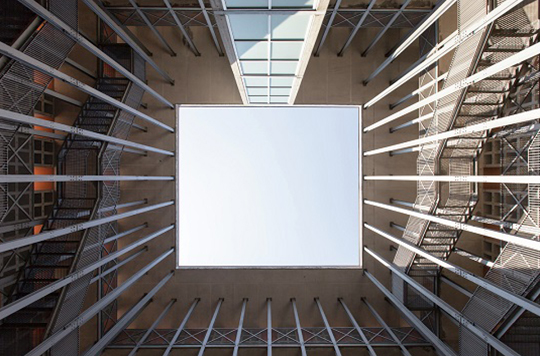Studio 08
Lives of Melbourne Museum & Archive (LOMMAA)
Domenic Trimboli

Studio Description
This speculative project is for the design of a public columbarium and interactive digital archive within the Melbourne CBD.
As an infinite number of cities around the world currently face a shortage of available land suitable for new cemeteries and rapidly evolving funerary traditions, this project speculates on the potential relevance of new, decentralised, funerary architectural typologies that might just mitigate the creation of new, large land reserves.
The columbarium component of the brief is modelled on the multi-story architectural developments contemporaneously occurring in several areas of Japan facing ageing populations and limited urban space. Complimenting this, the digital component of the brief will be used to explore and integrate new avenues for memorialisation within an architectural proposal. Students will be supported in developing their theoretical knowledge of these emerging technologies by the Deathtech Research Centre, based on the University campus (https://deathtech.research.unimelb.edu.au/).
Studio Outcomes
Beginning with a focused, group study of literary, philosophical and architectural precedents alongside technological trends; students will be expected to develop their brief using the Queen Victoria Markets Carpark – a site selected for both its centrality and attachment to Melbourne’s very first cemetery.
The brief anticipates a minimum of elements pertinent to funerary tradition and the typical design of a columbarium. Augmenting this however, is the opportunity to explore lessons from other building typologies such as archives, libraries, museums and galleries in order to speculate on how these might inform an ongoing curation of future memorial spaces.
It is therefore anticipated that students will develop an architectural proposal that pushes their knowledge learnt from studio resources and create an exciting, architectural typology that could form a precedent for future, non-landscape based cemetery developments.
Studio Leader
Domenic is a registered architect, freelance writer and recipient of the Nell Norris Fellowship for a PhD in Architecture at The University of Melbourne. His PhD research, developed through theoretical enquiry and speculative architectural design, asks us to reconsider our relationship towards existing cemeteries in Australia’s cities and to also think about how we might envisage creating new ones over the course of this century. Domenic is also an experienced tertiary tutor of architecture and urban planning that has had written work published across several design-based journals nationally and internationally.
Readings & References
- Arnold, M., et al. (Eds.). (2018). Death and Digital Media. Routledge.
- Cairns, S., & Jacobs, J. (2014). Buildings Must Die: A Perverse View of Architecture. MIT Press.
- Calvino, I. (2002) ‘Cities & Memory’ and ‘Cities & the Dead’. In Invisible Cities (originally Published in Italian, 1972). Penguin.
- Gould, H., Kohn, T., & Gibbs, M. (2018). Uploading the Ancestors: Experiments with digital Buddhist altars in contemporary Japan, Death Studies 43(7): 456-465.
- Gould, H., Odom, W., & Uriu, D. (2018). Understanding Automatic Conveyor-belt Columbaria: Emerging Sites of Interactive Memorialization in Japan (Hong Kong: Designing Interactive Systems Conference Proceedings).
- Hockey, J., Komaromy, C., & Woodthorpe, K. (Eds.). (2010). The Matter of Death: Space, Place and Materiality. Palgrave Macmillan.
- Page, A. (2021). Objects and Spirituality: Building on Country. In M. Neale (Ed.), Design: Building on Country (pp. 14-38). Thames & Hudson.
- Treib (Ed.). (2009). Spatial Recall: Memory in Architecture and Landscape. Routledge.
- Trimboli, D., & Juckes, B. (2019). Memento Memorial, Architecture Australia 108(3): 110-112.
- Upmeyer, B. (Ed.). (2019). Monu-Magazine 31 (After Life Urbanism).
Schedule Mondays and Thursdays 15:15-18:15